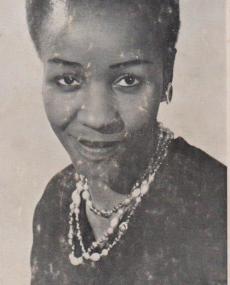
Helen Nontando (Noni) Jabavu was born in 1919 in the Eastern Cape into a literary family. From the age of thirteen, she was schooled in England, and continued to live there for many years. She went on to become one of the first African female writers and journalists.
In 1955 Noni Jabavu returned to South Africa for a three-month stay. She visited her father, Professor D.D.T. Jabavu, of Fort Hare, as well as relatives in the Eastern Cape and Johannesburg. The Ochre People, first published in 1963, is a poignant account of her trip, and contains vivid and perceptive memories of the country she loved and of the people she met.
The Ochre People is one of her two autobiographical works; the other is Drawn in Colour (1960). Both were written early in her literary career and have been hailed by critics as being brilliant and fascinating, the works indicate that she preferred positioning herself as being simultaneously an African and a European, tracing her origins in both England and South Africa. In her books she looked at the alienation she felt, issues of identity and the impact of the West on Africa.
The "Author's Note" from Drawn in Colour may also be of interest:
‘I belong to two worlds with two loyalties: South Africa, where I was born, and England, where I was educated. When I received a cable sent by my father, I flew back to South Africa to be amongst my Bantu people, leaving my English husband behind in London. Later that year, he and I went to live in East Africa, to be near my only sister who had married out there. I've told here something of my own background and circumstances. This is a personal account of an individual African's experiences and impressions of the differences between East and South Africa in their contact with Westernization’.
Jabavu died on 19 June 2008 at the age of 88. The following extract written by the poet, Makhosazana Xaba, is a fitting tribute to here writing and journalistic abilities:
‘When I decided to write Noni Jabavu’s biography, I was driven by intense curiousity and utter frustration at what seemed to me as a lack of recognition of her pioneering role as a writer and a journalist. One only has to read her two books (Drawn in Colour and The Ochre People) to realize just how skilled she was as a memoirist. Her journalistic column editorials demonstrate a reflective style that must have been unusual for her times. While interviewing Wally Serote who was living in Botswana during the same as Noni, I learned something that confirmed my initial thoughts on her. “We men, she said, did not know how to relate to her (Noni). She was a woman living far ahead of our times.” This speaks volumes considering Serote himself is a world-wise literary and cultural giant’. - Makhosazana Xaba (poet and writer)
*Note: Most of the biographical sketches of Jabavu list her year of birth as 1919, but one book, Women Writing Africa: the Southern Region, gives it as 1920.